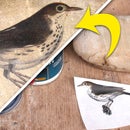Introduction: Basic Silver Soldering With Strong Joints
In this Instructable, I'll show you the absolute basics for making silver-soldered joints that are simple, and structural.
To accomplish this, these are the MAIN tools and supplies needed:
- Harris Safety-Silv 56%
- Harris Stay-Silv Flux
- Mapp Gas Torch (Propane torch is also acceptable!)
These accessories are a little more on the optional side, but highly recommended:
For safety when soldering or welding, use a respirator mask rated for gas/vapors. This is the respirator and cartridge combination I use:
If you would like to see the process from start to finish, including an example of joint strength, check out my video.
Step 1: Clean and Prepare Your Metal
The basic idea with silver soldering is less about "melting silver" and more about heating two separate pieces of metal to a point where the silver will flow onto and between them. This silver will then form a bond between the two pieces of metal. In the case of a high-silver solder like I use (Harris Safety-Silv 56%), the bond is VERY strong. As I show in my video, the joint can take significant stress and bending.
Before applying the solder or heat, each of your metal pieces has to be cleaned, especially if they are oily or rusty. I accomplish this with sandpaper. If it's really bad off, start with a file, then sandpaper.
Step 2: Apply Flux
Soldering flux must be applied to each metal surface at the joint. Flux prevents oxidation during the heating process, allowing the solder to flow properly onto/into those areas.
Step 3: Cut Your Silver Solder
While you CAN simply apply the silver solder directly from the roll while you are torching, you may end up using much more silver than you need to. I prefer to cut an appropriate-sized piece of silver solder for the joint.
Once you have your silver solder pieces cut, go ahead and apply flux to them as well.
TIP: For some joints, it may be easier to hammer and flatten the silver solder. You can also bend it to a curved shape or whatever you'd like, to help keep it in place while torching.
Step 4: Position Your Parts and Solder Pieces
Using your "helping hands", titanium clamps, metal assistance wire, or whatever your preferred clamping/holding setup may be, situate the pieces as you want them to be, and ensure they are butted together as CLOSELY as possible. You don't want any big gaps here. Silver solder flows well into areas that are tightly fitted.
Carefully place your silver solder pieces on top of the joints. The paste flux helps hold them in place initially.
Step 5: Apply Heat
Once everything is in position, you are ready to turn on the torch and apply heat.
(I almost always have to dial the heat back on my Mapp gas torch. You will get a feel for how much is too much.)
Start by moving the flame around the entire area, BROADLY sweeping in a circular motion.
At this point, you want to heat the METAL, not the solder!
Pay attention that you apply heat to BOTH pieces as evenly as possible. Thicker pieces require a little more heat. If you heat one side up too much, the silver will head in that direction. (But if that happens, "pull" it back by applying more heat to the other side.)
If your solder starts to move away from the joint, use your titanium pick to gently nudge it back into place.
The flux will bubble, and the silver solder will look really shiny, and eventually melt.
You want to watch that you don't make it bright orange. A DULL RED is ideal, and that's when the solder should flow.
Once the silver flows into the joint, give it a couple extra seconds of heat and pull away.
Turn off your torch and let the piece sit, undisturbed, until it cools completely. Do not quench in water.
Step 6: Pickle (or Just Sand It)
Once your piece is cooled, you can remove the clamps and it should all hold together on its own.
You'll notice the burnt flux and oxidation, which you'll want to remove.
You can use a "pickle" for this (see video for recipe) or you can simply sand it. My favorite way to finish the piece is with a wire brush attached to a drill.
Step 7: You've Got a Strong Silver-soldered Joint!
Give your joints a little twist/bend to be sure it's secure. I'm not saying to bend it out of whack, but just check to make sure it feels good and strong. :)
At this point you can apply a clear coating to your piece to prevent oxidation/rust, or you can leave it as is.
Harris Safety-Silv 56% works with steel, stainless steel, copper, brass and other metals. With stainless steel in particular, you can get some very nice, color-matched joints.
Step 8: Get Creative!
Have fun with it! My favorite part about this process is looking for metal pieces to combine and turn into something. Most often, I make little characters out of old nails, nuts, and bolts.
If you are interested in my work, please visit my Etsy shop:
https://www.etsy.com/shop/steadycraftin
Hopefully you have learned something from this tutorial. Thank you for watching and reading!
Your friend,
TheCrafsMan
SteadyCraftin











